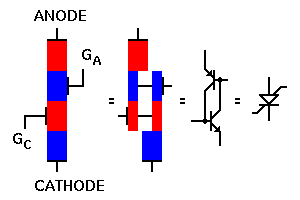|
|
www.play-hookey.com | Mon, 08-26-2002 |
| Digital | Logic Families | Digital Experiments | Analog | Optics | Computers | Semiconductors | Test HTML | ||
| Direct Links to Other Semiconductors Pages: | |
|---|---|
| Basic Semiconductor Structures: | [Basic Semiconductor Crystal Structure] [The PN Junction] [The Transistor] |
| Field Effect Transistors (FETs): | [Junction FET] [Depletion Mode MOSFET] [Enhancement Mode MOSFET] |
| Adding More Junctions: | [The Four-Layer Diode] [The Silicon Controlled Rectifier] [The Silicon Controlled Switch] [The Diac and Triac] |
| Specialized Devices: | [A Touch of Physics] [Specialized Diodes] [The Unijunction Transistor] |
| The Silicon Controlled Switch |
|---|

The silicon controlled switch (SCS) is the next step beyond the silicon controlled rectifier (SCR). It is still a four-layer diode, but this time all four regions are accessible to the external circuit.
The basic construction of the SCS is the same as for the SCR, with the addition of a second gate lead. We thus have an anode, a cathode, an anode gate, and a cathode gate. The equivalent circuit is the same as shown to the right, and even the schematic symbol of the SCS is similar to the SCR symbol.
The SCS has two advantages over the SCR and the four-layer diode. First, because both gate regions are accessible, they can be biased so as to completely cancel the rate effect we described with the four-layer diode. Second, since we can now control both end junctions, we can actively turn the SCS off without having to reduce the applied voltage or current. Thus, the SCS really is a switch, and can be used as one.
|
|
|
|
|
All pages on www.play-hookey.com copyright © 1996, 2000-2002 by
Ken Bigelow Please address queries and suggestions to: webmaster@play-hookey.com |